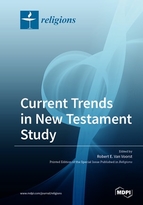Current Trends in New Testament Study
A special issue of Religions (ISSN 2077-1444).
Deadline for manuscript submissions: closed (1 February 2019) | Viewed by 55537
Special Issue Editor
Special Issue Information
Dear Colleagues,
This is a call for expressions of interest in contributing to a special issue on current New Testament study for the peer-reviewed electronic journal, Religions.
This issue will focus on the formal methods used to interpret the New Testament today. In line with the multiplicity of methods for interpretation of texts in the humanities in general, New Testament study has never before seen so many different methods. This situation poses both challenges and opportunities for researchers and students alike.
This issue will contain between twelve and fifteen contributions by established scholars and by younger scholars who have recently demonstrated their expertise in a certain method. These articles will reflect global perspectives on biblical interpretation. I expect that this issue will serve to inform both students and professors about some of the latest trends in methodology. Because Religions is a peer-reviewed open-access journal with a high rate of citation, you can be assured of rigorous academic quality, free access, and international exposure for your contribution.
Religions has been funded by the Knowledge Unlatched initiative, resulting in no direct charge to authors. For more information, see https://www.mdpi.com/journal/religions/apc .
Thank you for your interest in this topic, and best wishes in your academic work.
Prof. Dr. Robert E. Van Voorst
Guest Editor
Manuscript Submission Information
Manuscripts should be submitted online at www.mdpi.com by registering and logging in to this website. Once you are registered, click here to go to the submission form. Manuscripts can be submitted until the deadline. All submissions that pass pre-check are peer-reviewed. Accepted papers will be published continuously in the journal (as soon as accepted) and will be listed together on the special issue website. Research articles, review articles as well as short communications are invited. For planned papers, a title and short abstract (about 100 words) can be sent to the Editorial Office for announcement on this website.
Submitted manuscripts should not have been published previously, nor be under consideration for publication elsewhere (except conference proceedings papers). All manuscripts are thoroughly refereed through a double-blind peer-review process. A guide for authors and other relevant information for submission of manuscripts is available on the Instructions for Authors page. Religions is an international peer-reviewed open access monthly journal published by MDPI.
Please visit the Instructions for Authors page before submitting a manuscript. The Article Processing Charge (APC) for publication in this open access journal is 1800 CHF (Swiss Francs). Submitted papers should be well formatted and use good English. Authors may use MDPI's English editing service prior to publication or during author revisions.
Keywords
- African criticism
- Chinese criticism
- cultural anthropology criticism
- ecological criticism
- feminist criticism
- historical criticism
- inter-textual criticism
- LGBT criticism
- narrative criticism
- performance criticism
- post-colonial criticism
- reception history
- social identity criticism






